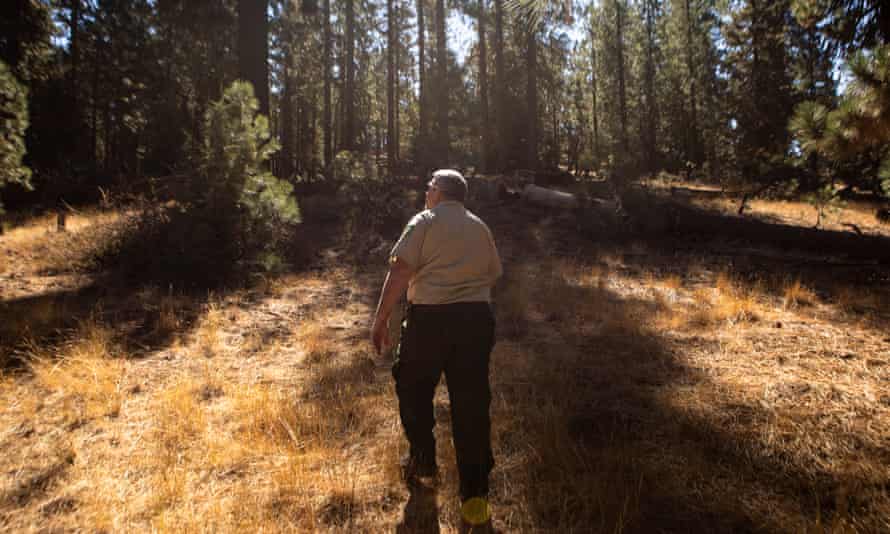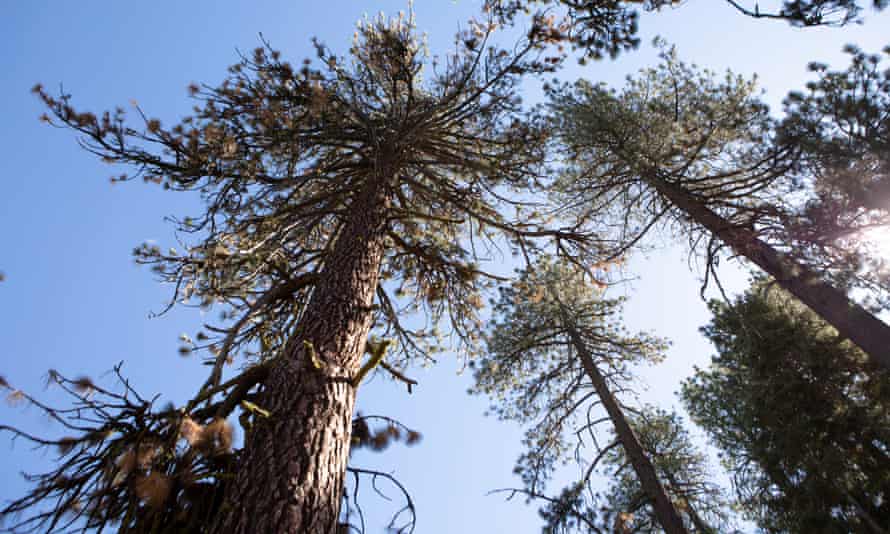In southern California forest officials back culling trees. Locals are furious
The measure could curb the wind-driven wildfires in the region, but critics want a deeper assessment

“That tree is dead. That tree is dead – we are too late for them,” Greg Thomson, the forester for Los Padres national forest says, as he traipses through a dense patch of conifers clustered on a peak overlooking Ventura county. Pine needles and yellowed grass crunch beneath his boots as he points to giant spiny tree skeletons with thick trunks.
These trees, he says, were victims of the drought, beetle infestations and a changing climate on an overgrown landscape that has not seen a good fire in too long – and it’s his job to do something about that.
“We don’t have a lot of forest out here and I don’t want to lose it all on my watch,” he says. “Our number one goal in Los Padres is to keep the forest here.”
That’s why the US forest service has approved a controversial plan to cull smaller trees from the area and carve a cleared line spanning more than 700 acres across the mountaintop. The “shaded fuel break”, a reduced mosaic of vegetation, will, according to officials, give firefighters a designated clearing to slow or stop flames at the ridge and remove the “fuel” that drives the most dangerous blazes.
Forest officials say it’s a strategy that will enable them to protect forest health, safeguard the habitats of threatened animals and slow the onslaught of wildfires.
But the Pine Mountain project has sharply divided officials, environmental activists, and locals. A coalition of advocacy organizations, including the Los Padres Forest Watch, the Centers for Biological Diversity, and the Wishtoyo Chumash Foundation, have rallied support from local city councils, county supervisors and local businesses against the proposal, citing concernsover its approval process and the potential to harm ecosystems.

There’s strong scientific consensus that, in crowded forests, treatments that remove overgrown vegetation are essential – the federal government, which manages roughly 57% of California’s forests, has also faced criticism that agencies are abysmally behind on using the treatments.
Controlled fires make space for trees to thrive, and they can’t be lit until the excess vegetation – referred to as “fuel” by officials and researchers – is cleared. When dense underbrush dies or dries, it feeds high-intensity wildfires that are difficult to contain and more likely to leave behind charred moonscapes that take a heavy toll on habitats and ecosystems. If the underbrush is not cleared, it can easily cause prescribed burns to rage out of control, much like the infernos they are supposed to stop.
Only a tiny fraction of the roughly 33m acres of California’s forests are treated each year, and scientists are clear that more thinning and prescribed burning is needed. With hot, dry days stretching fire weather longer each year, the window for conducting treatments is getting smaller. Some projects have faced long delays, tied up in legal battles with a vocal contingent of environmental advocates. This fiscal year the forest service completed only half the fuel treatments it had planned in California and according to scientists, that’s a big problem.
“There is no controversy among scientists on this at all. In the Sierra Nevada, fuel treatments, thinning and prescribed fire are absolutely essential,” says John Battles, a forest ecologist and professor at University of California Berkeley.
But the landscapes across these ridges of Los Padres are decidedly different from the forests in northern California and the Sierra Nevada. What works in the northern forests may not be what’s needed in the south, where fires are often driven by dry winds. “There the science on the efficacy of treatments is much more ambiguous”, Battles adds. “It is a legitimate concern of how much value is there.”
Rising roughly 7,000ft above the sprawling hillsides north of the town of Ojai, there’s a rich tapestry of colorful tufts coating the slopes. Sage, chamise, and scrub oak sprawl across the horizon – the vibrant yellows and greens of the coastal chaparral on full display. Nearly half the proposed fire break project will cut into these systems, which may not fare as well from the intervention.
Despite the opposition, the forest service has pushed forward with the Pine Mountain project. Thomson is quick to note that the largest trees will remain unless they pose a threat to roads or campsites. Those with a circumference between 18 and 24 inches are the main targets, and will be strategically culled.
The proposed fire break is far from the nearest town – which has sparked questions about its relevance. But Thomson says it is intended to stop or slow flames from reaching the sensitive habitats of threatened animals, including the spotted owl and California condor.

Situated between wilderness areas but with rare road access, the fire break will also enable the agency to manage and protect the land far beyond the project perimeter.
However, ecological sacrifices will be made. Native plants will be pulled from the ground. Trees that provide habitat for various plant and animal species will be taken off the land.
“There’s a tradeoff with everything”, says Nicole Molinari, an ecologist with the US forest service. “When I think about these forest health projects, there may be some short term impacts for a huge, long term gain,” she adds. “If these forests are lost to beetle mortality or drought or high severity fire, they could be gone forever.”
The forest service is prepared to cut through hundreds of acres of chaparral – and the rich and diverse ecosystems this shrubland supports – to protect the trees above.
“Bushes are second-class citizens compared to trees,” says ecologist Brad Shaffer, director of the UCLA La Kretz Center for California Conservation Science, noting that fire effects on this system are understudied, compared with the northern forests. Shaffer, who is studying how ecosystems recoveredafter the Woolsey fire, which torched the chaparral-covered mountains in Los Angeles and Ventura counties in 2018, said it largely comes down to public perception.
“Everybody says I want to go for a walk in the woods, not a walk in the bushes,” he says, which might be undercutting the need for a unique approach to preserving and protecting very different landscapes. “Managing fire in dry, western conifer forest is just a very different issue than managing it in very fire-prone chaparral and oak woodland.”
Chaparral burns differently and recovers differently after a fire, which is why it is defined by a different “fire regime” – a way of classifying landscapes and how often they were set ablaze historically. Fires that torch the coastal shrublands are naturally low in frequency but high in severity.
“Chaparral has a high-intensity, crown fire regime, meaning when a fire burns, it burns everything, frequently leaving behind an ashen landscape,” according to a report from the the California Chaparral Institute, a non-profit organization formed to protect the diverse native vegetation system. The group is one of those opposed to the USFS treatment plan.
While northern California forests have suffered from suppression policies that delivered too few fires, landscapes in the south have been harmed by the reverse – the high fire frequency left environmental degradation in its wake. Since fires in this region are more often wind-driven than fuel-driven, thinning does less to slow them down.

Research by forest service officials confirms as much.
“It is not easy to align fuel treatment goals in this vegetation with restoration goals – in fact, you really can’t do it,” said USFS ecologist Hugh Safford during a presentation given at the California chaparral symposium in 2018.
“It doesn’t mean we shouldn’t be doing it,” he said, noting that sometimes the only way to protect natural habitats at risk from frequent fire is through the tactical use of these treatments. “From the ecological viewpoint”, he says, the strategy “needs to be understood as a local resource sacrifice made in order to gain a benefit at the landscape scale”.
Close to half of the project’s perimeter – 314 acres – is covered in chaparral, and environmental advocates opposing the plan say it will do more to harm than help.
“They have a blanket, one-size-fits-all approach to how to deal with wildfire, and that’s problematic from an ecological perspective,” says Bryant Baker, the conservation director with Los Padres Forest Watch.
He advocates for a more hands-off approach, even if that means letting the landscapes as they are now go. “Forests are not museums,” he says. “They are not places where nothing changes over time. They are very dynamic. Trees live and they die and dead trees offer up a completely new habitat.” Standing dead trees, called snags, are quickly put to use by insects, woodpeckers, chipmunks, and other small creatures, he says.
Baker and other critics are concerned that human intervention will lead to even more losses. Walking through the project perimeter, Bryant falls to his knees, unearthing yellowed cheatgrass, an invasive species spotting the ground. It’s far more flammable than native species, increasing the risks of flashy, fast-moving flames. “The non-native grass is already here and all it needs is more disturbance to spread across this ridge line,” he says.
The forest service claims these issues were considered, but the proposal was approved under “categorical exclusion”, a USFS designation that enables federal managers to move forward without the need for a detailed environmental analysis.
Critics of the plan believe a deeper assessment is required. Thousands of public comments were submitted in opposition to the project before it was approved at the end of September. The California Department of Fish and Wildlife expressed concerns, citing the “high biological diversity” in the project area.
The Coastal Band of the Chumash Nation has also criticized the plan, citing the potential for cultural degradation. “These are public lands, these are sacred lands to us, they should be working with us,” says Mariza Sullivan, tribal chair of the Coastal Band of the Chumash Nation. “There is a legacy of institutional paternalism that leaves all of us with a desert instead of a garden.”
The USFS says that it consulted with the US fish and wildlife service to address possible biological and ecological impacts and with federally recognized tribes on the cultural impacts to these sacred sites. Thomson says the agency is open to hearing more feedback but insists the public’s fears have been placated.
There are also concerns that, under the guise of restoration, the USFS is green-lighting a logging project and opening the cherished area to industry interests. “The cost is on the taxpayer to do this work,” says the USFS ecologist Molinari. “If we can offset some of that cost by having a group who can actually benefit from the material come and remove it from the landscape – that’s a win-win.”
Thomson thinks the directive is clear. The USFS is supposed to manage the land, he says, as a valuable asset for the American people. He cares most about those trees at the top and is determined to save them. Comparing the roughly 750 acres to the burn scar of the Dixie fire that blackened close to a million acres this year, he sees this as a small sacrifice with the potential to stop a severe fire from reaching these trees.
Stepping close to the edge of the steep slope, Thomson picks up a pinecone from the forest floor. “If we can protect some of the stands on the ridge top and maintain that seed source, nature has a chance to come back,” he says, tossing the pinecone from the ledge. As it bounces quietly out of view he smiles: it’s distributing its seeds down below. “But if we lose all those trees and the seed source – we are out of luck.”